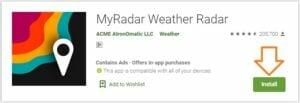

My radar for mac os Offline#
So werden Geräte, die ohnehin nicht erreichbar sind, gar nicht erst überprüft und fälschlicherweise als offline angezeigt. Indem Sie Scans Netzwerken zuordnen, weiß Network Radar immer ob dessen Geräte erreichbar sein sollten oder nicht. Sie möchten immer alle iPads in einem Ordner? Erstellen Sie einfach einen intelligenten Ordner und lassen Sie Network Radar die Arbeit machen. By binding scans to networks, Network Radar always knows if a devices is reachable or not, making it easy to refresh or monitor a bunch of devices even from different networks. You want all your iPads in one folder? Just create a smart folders and let Network Radar do the work. Die möglichen Konfigurationen sind schier endlos. Mit der Möglichkeit Regeln und Aktionen zu konfigurieren, können Sie beispielsweise per Email benachrichtig werden, wenn ein bestimmter Server nicht mehr erreichbar ist oder einer bestimmten Gruppe von Geräten automatisch das passende Gerätebild zuweisen. Zusätzlich können Sie Benachrichtigungen erhalten, wenn ein Gerät dem Netzwerk beitritt oder dieses verlässt. Alle Eigenschaftsänderungen werden lückenlos protokolliert. Lassen Sie Ihre Netzwerkgeräte von Network Radar beobachten. With the possibility to configure custom rules and actions Network Radar can send yourself a mail as soon as a certain server goes offline or play a sound when a FTP Server connects to your network. You may also want to receive notifications when a device enters or leaves your network. All changes are logged so you always know what happened when. Let Network Radar monitor a scan and get updates on changes in your network. Je nach Netzwerk und Gerät werden folgende Informationen angezeigt: IPv6-, IPv6- und MAC-Adresse, Herstellername, DNS Namen, mDNS Name, NetBIOS Name, NetBIOS Domain, offene Ports, Antwortzeit und vieles mehr. Um mehr Details zu sehen selektieren Sie einfach eines der Geräte. Die gefundenen Geräte weren übersichtlich aufgelistet. Es ist keinerlei Konfiguration notwendig. Mit nur einem Klick sucht Network Radar Ihr Netzwerk nach Geräten ab. Select a device on the list to see more details, such as IP, IPv6 and MAC address, vendor name, DNS names, mDNS name, NetBIOS name, NetBIOS domain, open ports, response time and more. Once Network Radar has scanned your network, it lists all devices – even those that have been online before you started the first scan. 157.Everything you'd like to know about your network devices.Īlles was Sie über die Geräte in Ihrem Netzwerk wissen möchten.Īll you have to do is clicking the Scan button. If you have questions or comments concerning the weather maps, or you need further assistance, please contact: 30 ext. Please credit the NOAA Central Library Data Imaging Project when using these weather maps. The daily weather maps for the period January 1 - August 6, 1914, also include a Northern Hemisphere map with data table.įunding for this project was provided by the NOAA Climate Database Modernization Program (CDMP), National Climatic Data Center, Asheville, NC. By the end of 1872 the map had acquired the format it would use for the rest of its run.

The Signal Office also added a general discussion of synoptic weather features and forecast, and then isobars and isotherms, on the maps. Within a short time the Signal Office added a table showing the change in barometric pressure during the most recent 8 hours, the temperature change within the most recent 24 hours, relative humidity, and total precipitation within the most recent 24 hours. with the day's air temperature, barometric pressure, wind velocity and direction, and a general indication of the weather for various cities around the country plotted directly on the map. The earliest weather maps featured only a map of the continental U.S. In 1969, the Weather Bureau began publishing a weekly compilation of daily maps with the title Daily Weather Maps (Weekly series). In 1913, the title became simply Daily Weather Map. When the meteorological activities of the Signal Corps were transferred to the newly-created Weather Bureau in 1891, the title of the weather map changed to the Department of Agriculture Weather Map.

Signal Office began publishing weather maps as the War Department Maps on Jan.


 0 kommentar(er)
0 kommentar(er)
